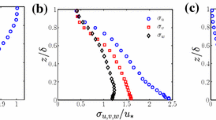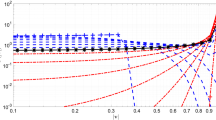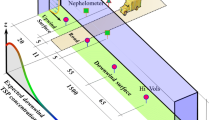Abstract
The joint probability density function (PDF) of turbulent velocity and concentration of a passive scalar in an urban street canyon is computed using a newly developed particle-in-cell Monte Carlo method. Compared to moment closures, the PDF methodology provides the full one-point one-time PDF of the underlying fields containing all higher moments and correlations. The small-scale mixing of the scalar released from a concentrated source at the street level is modelled by the interaction by exchange with the conditional mean (IECM) model, with a micro-mixing time scale designed for geometrically complex settings. The boundary layer along no-slip walls (building sides and tops) is fully resolved using an elliptic relaxation technique, which captures the high anisotropy and inhomogeneity of the Reynolds stress tensor in these regions. A less computationally intensive technique based on wall functions to represent the boundary layers and its effect on the solution are also explored. The calculated statistics are compared to experimental data and large-eddy simulation. The present work can be considered as the first example of computation of the full joint PDF of velocity and a transported passive scalar in an urban setting. The methodology proves successful in providing high level statistical information on the turbulence and pollutant concentration fields in complex urban scenarios.
Similar content being viewed by others
References
Bacon DP, Ahmad NN, Boybeyi Z, Dunn TJ, Hall MS, Lee PCS, Sarma RA, Turner MD III, Waight KT, Young SH, Zack JW (2000) A dynamically adapting weather and dispersion model: the operational multiscale environment model with grid adaptivity (OMEGA). Mon Weather Rev 128: 2044–2076
Baik J-J, Kim J-J (1999) A numerical study of flow and pollutation dispersion characteristic in urban street canyons. J Appl Meteorol 38: 1576–1589
Bakosi J, Franzese P, Boybeyi Z (2007) Probability density function modeling of scalar mixing from concentrated sources in turbulent channel flow. Phys Fluids 19(11):115106. http://link.aip.org/link/?PHF/19/115106/1
Bakosi J, Franzese P, Boybeyi Z (2008) A non-hybrid method for the PDF equations of turbulent flows on unstructured grids. J Comput Phys 227(11): 5896–5935
Cassiani M, Giostra U (2002) A simple and fast model to compute concentration moments in a convective boundary layer. Atmos Environ 36(30): 4717–4724
Cassiani M, Franzese P, Giostra U (2005a) A PDF micromixing model of dispersion for atmospheric flow Part I: development of the model, application to homogeneous turbulence and to neutral boundary layer. Atmos Environ 39(8): 1457–1469
Cassiani M, Franzese P, Giostra U (2005b) A PDF micromixing model of dispersion for atmospheric flow. Part II: application to convective boundary layer. Atmos Environ 39(8): 1471–1479
Cassiani M, Radicchi A, Albertson JD (2007) Modelling of concentration fluctuations in canopy turbulence. Boundary-Layer Meteorol 122(3): 655–681
Chatwin PC, Sullivan PJ (1993) The structure and magnitude of concentration fluctuations. Boundary-Layer Meteorol 62: 269–280
Dopazo C (1994) Recent developments in pdf methods. In: Libby PA (eds) Turbulent reactive lows. Academic Publishers, New York, pp 375–474
Dopazo C, O’Brien EE (1974) An approach to the autoignition of a turbulent mixture. Acta Astronaut 1: 1239–1266
Dreeben TD, Pope SB (1997a) Probability density function and Reynolds-stress modeling of near-wall turbulent flows. Phys Fluids 9(1):154–163. http://link.aip.org/link/?PHF/9/154/1
Dreeben TD, Pope SB (1997b) Wall-function treatment in pdf methods for turbulent flows. Phys Fluids 9(9):2692–2703. http://link.aip.org/link/?PHF/9/2692/1
Dreeben TD, Pope SB (1998) Probability density function/Monte Carlo simulation of near-wall turbulent flows. J Fluid Mech 357: 141–166
Durbin PA (1993) A Reynolds stress model for near-wall turbulence. J Fluid Mech 249: 465–498
Fox RO (1996) On velocity-conditioned scalar mixing in homogeneous turbulence. Phys Fluids 8(10): 2678–2691. http://link.aip.org/link/?PHF/8/2678/1
Fox RO (2003) Computational models for turbulent reacting flows. Cambridge University Press, Cambridge, 438 pp
Franzese P (2003) Lagrangian stochastic modeling of a fluctuating plume in the convective boundary layer. Atmos Environ 37: 1691–1701
Geuzaine C, Remacle J-F (2009) Gmsh: a three-dimensional finite element mesh generator with built-in pre- and post-processing facilities (accepted for publication). Int J Numer Meth Eng
Grigoryev YN, Vshivkov VA, Fedoruk MP (2002) Numerical “particle-in-cell” methods: theory and applications. Utrecht, Boston, 250 pp
Haworth DC, Pope SB (1986) A generalized Langevin model for turbulent flows. Phys Fluids 29(2):387–405. http://link.aip.org/link/?PFL/29/387/1
Haworth DC, Pope SB (1987) A pdf modeling study of self-similar turbulent free shear flows. Phys Fluids 30(4):1026–1044. http://link.aip.org/link/?PFL/30/1026/1
Hoydysh WG, Griffiths RA, Ogawa Y (1974) A scale model study of the dispersion of pollution in street canyons. In: 67th annual meeting of the air pollution control association, Denver, Colorado, APCA Paper No. 74–157.
Huang H, Akutsu Y, Arai M, Tamura M (2000) A two-dimensional air quality model in an urban street canyon: elevation and sensitivity analysis. Atmos Environ 34: 689–698
Jenny P, Pope SB, Muradoglu M, Caughey DA (2001) A hybrid algorithm for the joint PDF equation of turbulent reactive flows. J Comput Phys 166: 218–252
Johnson GT, Hunter LJ (1995) A numerical study of dispersion of passive scalar in city canyons. Boundary-Layer Meteorol 75: 235–262
Kloeden PE, Platen E (1999) Numerical solution of stochastic differential equations. Springer, Berlin, p 636 pp
Kristensen L (1994) Recurrence of extreme concnetrations. In: Grining S-V, Millán MM (eds) Air pollution modelling and its application. X. Plenum Press, New York
Lee IY, Park HM (1994) Parameterization of the pollutant transport and dispersion in urban street canyons. Atmos Environ 28: 2343–2349
Lien FS, Yee E, Cheng Y (2004) Simulation of mean flow and turbulence over a 2d building array using high-resolution CFD and a distributed drag force approach. J Wind Eng Ind Aerodyn 92(2): 117–158
Liu C-H, Barth MC (2002) Large-eddy simulation of flow and scalar transport in a modeled street canyon. J Appl Meteorol 41(6): 660–673
Luhar AK, Hibberd MF, Borgas MS (2000) A skewed meandering-plume model for concentration statistics in the convective boundary layer. Atmos Environ 34: 3599–3616
Lundgren TS (1969) Model equation for nonhomogeneous turbulence. Phys Fluids 12(3):485–497. http://link.aip.org/link/?PFL/12/485/1
Meroney RN, Pavageau M, Rafailidis S, Schatzmann M (1996) Study of line source characteristics for 2-d physical modelling of pollutant dispersion in street canyons. J Wind Eng Ind Aerodyn 62(1): 37–56
Mobus H, Gerlinger P, Bruggemann D (2001) Comparison of eulerian and lagrangian monte carlo pdf methods for turbulent diffusion flames. Combust Flame 124: 519–534
Muradoglu M, Jenny P, Pope SB, Caughey DA (1999) A consistent hybrid finite-volume/particle method for the PDF equations of turbulent reactive flows. J Comput Phys 154: 342–371
Muradoglu M, Pope SB, Caughey DA (2001) The hybrid method for the PDF equations of turbulent reactive flows: consistency conditions and correction algorithms. J Comput Phys 172: 841–878
Pavageau M (1996) Concentration fluctuations in urban street canyons—groundwork for future studies. Tech. rep, Meteorological Institute of the University of Hamburg
Pavageau M, Schatzmann M (1999) Wind tunnel measurements of concentration fluctuations in an urban street canyon. Atmos Environ 33: 3961–3971
Pope SB (1985) PDF methods for turbulent reactive flows. Prog Energ Combust 11: 119–192
Pope SB (1994) On the relationship between stochastic Lagrangian models of turbulence and second-moment closures. Phys Fluids 6(2):973–985. http://link.aip.org/link/?PHF/6/973/1
Pope SB (1998) The vanishing effect of molecular diffusivity on turbulent dispersion: implications for turbulent mixing and the scalar flux. J Fluid Mech 359: 299–312
Pope SB (2000) Turbulent flows. Cambridge University Press, Cambridge, 770 pp
Rafailids S, Schatzmann M (1995) Physical modelling of car exhaust disperision in urban street canyons. In: Proc 21st int meeting on air pollution modelling and its applications, Baltimore, Nov 6–10
Rembold B, Jenny P (2006) A multiblock joint pdf finite-volume hybrid algorithm for the computation of turbulent flows in complex geometries. J Comput Phys 220: 59–87
Rotta JC (1951) Statistiche theorie nichthomogener turbulenz. Z Phys 129: 547
Sawford BL (2004) Micro-mixing modelling of scalar fluctuations for plumes in homogeneous turbulence. Flow Turbul Combust 72: 133–160
Sawford BL (2006) Lagrangian modeling of scalar statistics in a double scalar mixing layer. Phys Fluids 18(8):085108. http://link.aip.org/link/?PHF/18/085108/1
Soulard O, Sabel’nikov VA (2006) Eulerian Monte Carlo method for the joint velocity and mass-fraction probability function in turbulent reactive gas flows. Combust Explo Shock 42: 753–762
Speziale CG, Sarkar S, Gatski TB (1991) Modelling the pressure-strain correlation of turbulence: an invariant dynamical systems approach. J Fluid Mech 227: 245–272
Valiño L (1998) A field Monte Carlo formulation for calculating the probability density function of a single scalar in a turbulent flow. Flow Turbul Combust 60:157–172
van Kampen NG (2004) Stochastic processes in physics and chemistry, 2nd edn. North Holland, Elsevier B.V, Amsterdam, The Netherlands, 464 pp
van Slooten PR, Jayesh, Pope SB (1998). Advances in PDF modeling for inhomogeneous turbulent flows. Phys Fluids 10(1):246–265. http://link.aip.org/link/?PHF/10/246/1
Villermaux J, Devillon JC (1972) Représentation de la coalescence et de la redispersion des domaines de ségrégation dans un fluide par un modèle d’interaction phénoménologique. In: Proceedings of the 2nd intl. symp. on chemical reaction engineering. Elsevier, New York, pp 1–13
Wacławczyk M, Pozorski J, Minier J-P (2004) Probability density function computation of turbulent flows with a new near-wall model. Phys Fluids 16(5):1410–1422. http://link.aip.org/link/?PHF/16/1410/1
Wedding JB, Lambert DJ, Cermak JE (1977) A wind tunnel study of gaseous pollutants in city street canyons. Air Pollut Control Assoc J 27: 557–566
Whizman V, Laurence D, Kanniche M, Durbin PA, Demuren A (1996) Modeling near-wall effects in second-moment closures by elliptic relaxation. Int J Heat Fluid Flow 17: 255–266
Wilson DJ (1995) Concentration fluctuations and averaging time in vapor clouds. In: (eds) Center for Chemical Process Safety. American Institute of Chemical Engineers, New York, p 181
Yee E, Chan R, Kosteniuk PR, Chandler GM, Biltoft CA, Bowers JF (1994) Incorporation of internal fluctuations in a meandering plume model of concentration fluctuations. Boundary-Layer Meteorol 67(1–2): 11–39
Yee E, Wilson DJ (2000) A comparison of the detailed structure in dispersin tracer plumes measured in grid-generated turbulence with a meandering plume model incorporating internal fluctuations. Boundary-Layer Meteorol 94(2): 253–296
Author information
Authors and Affiliations
Corresponding author
Rights and permissions
About this article
Cite this article
Bakosi, J., Franzese, P. & Boybeyi, Z. Joint PDF Modelling of Turbulent Flow and Dispersion in an Urban Street Canyon. Boundary-Layer Meteorol 131, 245–261 (2009). https://doi.org/10.1007/s10546-009-9370-x
Received:
Accepted:
Published:
Issue Date:
DOI: https://doi.org/10.1007/s10546-009-9370-x




